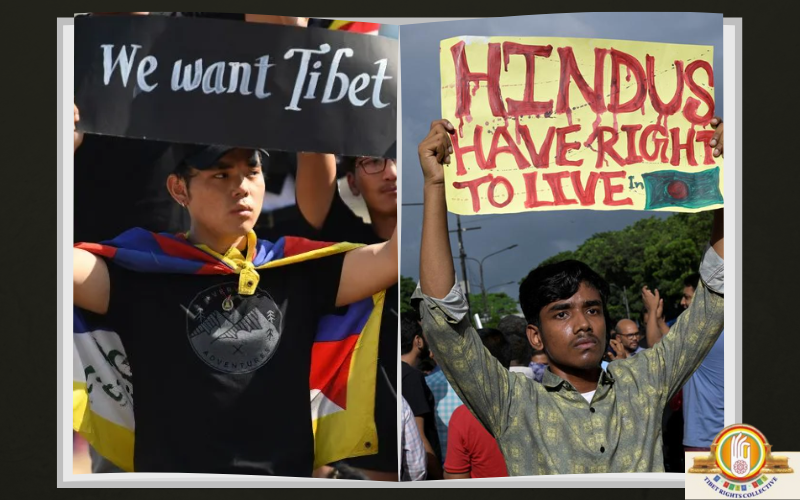
Bangladesh Radicalism vs Invasion of Tibet
The persecution of communities due to political upheaval and sectarianism reveals deep-seated issues of intolerance and repression. Two gut wrenching examples of such suffering are the Tibetan people’s experience following the Chinese occupation in 1950 and the ongoing violence against Hindus in Bangladesh. Both scenarios highlight the devastating impact of political instability on cultural and religious identities.
Tibetan Suffering Under Chinese Occupation
In 1950, the People’s Liberation Army of China invaded Tibet, initiating a brutal occupation that profoundly altered the lives of Tibetans, who had previously been the majority in their own land. The Chinese government’s policies led to significant human rights abuses and the systematic dismantling of Tibetan culture and religion.
1. Cultural Erasure: The Chinese authorities pursued policies designed to undermine and destroy Tibetan cultural and religious practices. Monasteries were demolished, Tibetan Buddhist leaders were persecuted, and traditional practices were prohibited. The destruction of these spiritual and cultural institutions marked a significant loss for the Tibetan people, who had been deeply connected to their religious heritage.
2. Mass Killings: During the early years of the occupation, the Chinese government’s crackdown on resistance resulted in numerous deaths. Tibetans faced executions and torture as the Chinese authorities sought to suppress any form of dissent and assert control over the region. This period witnessed a tragic loss of life and a profound trauma for the Tibetan population.
3. Forced Assimilation: The Chinese government implemented policies aimed at integrating Tibet into the People’s Republic of China. These included the promotion of Chinese language and culture over Tibetan traditions, leading to the gradual erosion of Tibetan identity and heritage.
Current Anti-Hindu Violence in Bangladesh
Today, a similar pattern of persecution is evident in Bangladesh, where the Hindu community is facing violence amid recent political turmoil. This violence reflects a disturbing trend of intolerance and sectarianism that threatens the cultural and religious fabric of the Hindu population.
1. Cultural Destruction: Hindu temples, homes, and businesses are being targeted and destroyed in Bangladesh. These attacks represent a deliberate attempt to erase the cultural and religious heritage of the Hindu community. The vandalism of historical temples and institutions signifies a broader effort to undermine the identity and traditions of Hindus in the region.
2. Violence and Killings: The current violence has led to deaths and injuries, with reports highlighting the severity of the situation. The killing of a school teacher and the widespread violence are intended to instill fear and marginalize the Hindu community. This reflects a broader pattern of targeting minorities in times of political upheaval.
3. Forced Migration: Many Hindus are attempting to flee to neighboring India as a result of the violence, seeking safety from the attacks. This mass movement mirrors the forced displacement experienced by many Tibetans during the early years of the Chinese occupation.
Comparative Analysis
Both the Tibetan experience and the current situation in Bangladesh illustrate the devastating effects of political instability and sectarian intolerance on communities. In Tibet, the invasion and subsequent occupation led to the erosion of Tibetan identity and significant loss of life. In Bangladesh, the violence against Hindus reflects a similar pattern of cultural destruction and persecution during times of political turmoil.
These cases underscore the universal struggle for minority rights and the protection of cultural heritage. They highlight the need for global attention and intervention to prevent such atrocities and to support affected communities.
The international community must advocate for human rights, protect cultural heritage, and support those who are suffering due to political instability and sectarian violence. The experiences of Tibetans in the 1950s and the current plight of Hindus in Bangladesh serve as somber reminders of the ongoing challenges faced by communities under threat and the imperative to ensure their safety and dignity.